Ensuring the Sustainability of Arctic Industrial Facilities under Conditions of Global Climate Change
Abstract
:1. Introduction
1.1. Increase of CO2 Emissions as Permafrost Melts
1.2. Rising Global Sea Levels and Risk to Infrustructure
2. Materials and Methods
2.1. Proposed Solution for Remote Arctic Oil and Gas Facilities
2.2. Physical and Mathematical Modeling of Geotechnical Solutions for the Location of Arctic Oil and Gas Facilities under Climate Change
2.3. Proposed Solution for the Stability of Pile Foundations in Permafrost
3. Results and Analysis
4. Discussion
- determination of the list of necessary initial data for modeling the bearing capacity of piles for individual modules (taking into account concentrated and distributed loads on the pile foundation);
- development of a sketch of the general plan of the object.
- modeling of bearing capacity and selection of characteristics of pile fields (type of pile and its geometric characteristics, distance between piles and method of installation) according to engineering survey data;
- modeling of thawing of frozen soils with different dynamics of changes in average annual temperatures.
- selection of a list of measures to preserve the bearing capacity of piles, depending on the results presented in the second block;
- year-round monitoring of the stability of the facility during the entire period of its operation.
5. Conclusions
Author Contributions
Funding
Data Availability Statement
Acknowledgments
Conflicts of Interest
References
- Zhukovskiy, Y.; Tsvetkov, P.; Buldysko, A.; Malkova, Y.; Stoianova, A.; Koshenkova, A. Scenario Modeling of Sustainable Development of Energy Supply in the Arctic. Resources 2021, 10, 124. [Google Scholar] [CrossRef]
- The Intergovernmental Panel on Climate Change. Global Warming of 1.5 C. Available online: www.ipcc.ch (accessed on 23 November 2021).
- Masson-Delmotte, V.; Zhai, P.; Pörtner, H.-O.; Roberts, D.; Skea, J.; Shukla, P.R.; Pirani, A.; Moufouma-Okia, W.; Péan, C.; Pidcock, R.; et al. IPCC Special Report: Global Warming of 1.5 C—Summary for Policymakers; World Meteorological Organization: Geneva, Switzerland, 2018; 32p.
- Stocker, T.F.; Qin, D.; Plattner, G.-K.; Tignor, M.; Allen, S.K.; Boschung, J.; Nauels, A.; Xia, Y.; Bex, V.; Midgley, P.M. IPCC. Summary for Policymakers. In Climate Change 2013: The Physical Science Basis. Contribution of Working Group I to the Fifth Assessment Report of the Intergovernmental Panel on Climate Change; Cambridge University Press: Cambridge, UK; New York, NY, USA, 2013; 28p, Available online: http://www.ipcc.ch/pdf/assessment-report/ar5/wg1/WG1AR5_SPM_FINAL.pdf (accessed on 23 November 2021).
- Meinshausen, M.; Smith, S.J.; Calvin, K.; Daniel, J.S.; Kainuma, M.L.T.; Lamarque, J.F.; Matsumoto, K.; Montzka, S.A.; Raper, S.C.B.; Riahi, K.; et al. The RCP greenhouse gas concentrations and their extensions from 1765 to 2300. Clim. Chang. 2011, 109, 213–241. [Google Scholar] [CrossRef] [Green Version]
- Le Quéré, C.; Andrew, R.M.; Friedlingstein, P.; Sitch, S.; Hauck, J.; Pongratz, J.; Pickers, P.A.; Korsbakken, J.I.; Peters, G.P.; Canadell, J.G.; et al. Global Carbon Budget 2018. Earth Syst. Sci. Data 2018, 10, 2141–2194. [Google Scholar] [CrossRef] [Green Version]
- Biskaborn, B.K.; Smith, S.L.; Noetzli, J.; Matthes, H.; Vieira, G.; Streletskiy, D.A.; Schoeneich, P.; Romanovsky, V.E.; Lewkowicz, A.G.; Abramov, A.; et al. Permafrost is warming at a global scale. Nat. Commun. 2019, 10, 264. [Google Scholar] [CrossRef] [Green Version]
- Rajendran, S.; Sadooni, F.N.; Al-Kuwari, H.A.-S.; Oleg, A.; Govil, H.; Nasir, S.; Vethamony, P. Monitoring oil spill in Norilsk, Russia using satellite data. Sci. Rep. 2021, 11, 3817. [Google Scholar] [CrossRef]
- Meredith, M.; Sommerkorn, M.; Cassotta, S.; Derksen, C.; Ekaykin, A.; Hollowed, A.; Kofinas, G.; Mackintosh, A.; Melbourne-Thomas, J.; Muelbert, M.M.C.; et al. Chapter 3: Polar regions. In The Ocean and Cryosphere in a Changing Climate: Summary for Policymakers; Intergovernmental Panel on Climate Change; 2019; pp. 3-1–3-173. Available online: https://www.ipcc.ch/srocc/chapter/chapter-3-2/ (accessed on 23 November 2021).
- Moon, T.A.; Overeem, I.; Druckenmiller, M.; Holland, M.; Huntington, H.; Kling, G.; Lovecraft, A.L.; Miller, G.; Scambos, T.; Schädel, C.; et al. The expanding footprint of rapid Arctic change. Earths Future 2019, 7, 212–218. [Google Scholar] [CrossRef] [Green Version]
- Koven, C.D.; Ringeval, B.; Friedlingstein, P.; Ciais, P.; Cadule, P.; Khvorostyanov, D.; Krinner, G.; Tarnocai, C. Permafrost carbon-climate feedbacks accelerate global warming. Proc. Natl. Acad. Sci. USA 2011, 108, 14769–14774. [Google Scholar] [CrossRef] [Green Version]
- Timofeev, A.V.; Piirainen, V.Y.; Bazhin, V.Y.; Titov, A.B. Operational Analysis and Medium-Term Forecasting of the Greenhouse Gas Generation Intensity in the Cryolithozone. Atmosphere 2021, 12, 1466. [Google Scholar] [CrossRef]
- Vincent, W.F. Arctic Climate Change: Local Impacts, Global Consequences, and Policy Implications. In The Palgrave Handbook of Arctic Policy and Politics; Springer International Publishing: Cham, Switzerland, 2020. [Google Scholar]
- Pörtner, H.-O.; Roberts, D.C.; Masson-Delmotte, V.; Zhai, P.; Tignor, M.; Poloczanska, E.; Mintenbeck, K.; Alegría, A.; Nicolai, M.; Okem, A.; et al. Summary for Policymakers. In IPCC Special Report on the Ocean and Cryosphere in a Changing Climate; 2019; Available online: https://www.ipcc.ch/site/assets/uploads/sites/3/2019/11/03_SROCC_SPM_FINAL.pdf (accessed on 23 November 2021).
- Church, J.A.; White, N.J. Sea-Level Rise from the Late 19th to the Early 21st Century. Surv. Geophys. 2011, 32, 585–602. [Google Scholar] [CrossRef] [Green Version]
- Domingues, R.; Goni, G.; Baringer, M.; Volkov, D. What Caused the Accelerated Sea Level Changes along the U.S. East Coast during 2010–2015. Geophys. Res. Lett. 2018, 45, 13367–13376. [Google Scholar] [CrossRef]
- Leuliette, E. The Budget of Recent Global Sea Level Rise 2005–2013; National Oceanic and Atmospheric Administration: Washington, DC, USA, 2014. Available online: https://www.star.nesdis.noaa.gov/socd/lsa/SeaLevelRise/documents/NOAA_NESDIS_Sea_Level_Rise_Budget_Report_2014.pdf (accessed on 23 November 2021).
- Sweet, W.V.; Kopp, R.E.; Weaver, C.P.; Obeysekera, T.; Horton, R.M.; Thieler, E.R.; Zervas, C. Global and Regional Sea Level Rise Scenarios for the United States. In NOAA Technical Report NOS CO-OPS 083; National Oceanic and Atmospheric Administration: Washington, DC, USA, 2017; 75p. Available online: https://tidesandcurrents.noaa.gov/publications/techrpt83_Global_and_Regional_SLR_Scenarios_for_the_US_final.pdf (accessed on 23 November 2021).
- Sweet, W.V.; Park, J.; Marra, J.J.; Zervas, C.; Gill, S. Sea level rise and nuisance flood frequency changes around the U.S. In NOAA Technical Report NOS CO-OPS 73; National Oceanic and Atmospheric Administration: Washington, DC, USA, 2014; 53p. Available online: https://tidesandcurrents.noaa.gov/publications/NOAA_Technical_Report_NOS_COOPS_073.pdf (accessed on 23 November 2021).
- Church, J.A.; Clark, P.U.; Cazenave, A. Sea Level Change. CUP 2013, 13, 1137–1216. [Google Scholar]
- Romasheva, N.; Dmitrieva, D. Energy Resources Exploitation in the Russian Arctic: Challenges and Prospects for the Sustainable Development of the Ecosystem. Energies 2021, 14, 8300. [Google Scholar] [CrossRef]
- Tcvetkov, P.; Cherepovitsyn, A.; Makhovikov, A. Economic assessment of heat and power generation from small-scale liquefied natural gas in Russia. Energy Rep. 2020, 6, 391–402. [Google Scholar] [CrossRef]
- Tretyakov, N.; Cherepovitsyn, A.; Komendantova, N. Technology predictions for arctic hydrocarbon development: Digitalization potential, 5th International Conference on Technological Transformation: A New Role for Human, Machines and Management. Technol. Transform. 2020, 157, 241–251. [Google Scholar] [CrossRef]
- Dmitrieva, D.; Romasheva, N. Sustainable Development of Oil and Gas Potential of the Arctic and Its Shelf Zone: The Role of Innovations. J. Mar. Sci. Eng. 2020, 8, 1003. [Google Scholar] [CrossRef]
- Carayannis, E.G.; Ilinova, A.; Cherepovitsyn, A. The Future of Energy and the Case of the Arctic Offshore: The Role of Strategic Management. J. Mar. Sci. Eng. 2021, 9, 134. [Google Scholar] [CrossRef]
- Obu, J.; Westermann, S.; Bartsch, A.; Berdnikov, N.; Christiansen, H.H.; Dashtseren, A.; Zou, D. Northern Hemisphere permafrost map based on TTOP modelling for 2000–2016 at 1 km2 scale. Earth Sci. Rev. 2019, 193, 300–316. [Google Scholar] [CrossRef]
- Tokarev, I.V. Use of isotope data (δ2H, δ18O, 234U/238U) in the study of permafrost degradation processes as a result of long-term climate variations. J. Min. Inst. 2008, 176, 191. [Google Scholar]
- Vasiliev, G.G.; Dzhaljabov, A.A.; Leonovich, I.A. Analysis of the causes of engineering structures deformations at gas industry facilities in the permafrost zone. J. Min. Inst. 2021, 249, 377–385. [Google Scholar] [CrossRef]
- Vernigor, V.M.; Morozov, K.V.; Bobrovnikov, V.N. On approaches to designing of thermal regime at ore mines under permafrost conditions. J. Min. Inst. 2013, 205, 139–140. [Google Scholar]
- Potapov, A.I.; Pavlov, I.V. Acoustic emission diagnostics buildings mining companies in the North. J. Min. Inst. 2014, 209, 128–132. [Google Scholar]
- Vasiltsov, V.S.; Vasiltsova, V.M. Strategic planning of arctic shelf development using fractal theory tools. J. Min. Inst. 2018, 234, 663. [Google Scholar] [CrossRef]
- Mangushev, R.; Sakharov, I. Foundations and Foundations: Textbook for Bachelors of Construction and Specialists in the Field of Construction of Unique Buildings and Structures; Publishing house ASV: Moscow, Russia, 2019; 468p. [Google Scholar]
- Jorgenson, M.T.; Grosse, G. Remote Sensing of Landscape Change in Permafrost Regions. Permafr. Periglac. Process. 2016, 27, 324–338. [Google Scholar] [CrossRef]
- Korobkov, G.E.; Yanchushka, A.P.; Zakiryanov, M.V. Numerical modeling of a stress-strain state of a gas pipeline with cold bending offsets according to in-line inspection. J. Min. Inst. 2018, 234, 643. [Google Scholar] [CrossRef]
- Islamov, S.; Grigoriev, A.; Beloglazov, I.; Savchenkov, S.; Gudmestad, O.T. Research Risk Factors in Monitoring Well Drilling—A Case Study Using Machine Learning Methods. Symmetry 2021, 13, 1293. [Google Scholar] [CrossRef]
- Litvinenko, V.S.; Trushko, V.L.; Dvoinikov, M.V. Method of Ice-Resistant Drilling Platform Construction on Shallow Shelf of Arctic Seas. Patent for Invention RU 273739, 27 November 2020. [Google Scholar]
- Litvinenko, V.S.; Trushko, V.L.; Dvoinikov, M.V. Method for the Construction of an Offshore Drilling Platform on the Shallow Shelf of the Arctic Seas. Patent for Invention RU 2704451, 28 October 2019. [Google Scholar]
- Litvinenko, V.S.; Trushko, V.L.; Dvoinikov, M.V. Elaboration of a conceptual solution for the development of the Arctic shelf from seasonally flooded coastal areas. Int. J. Min. Sci. Technol. 2021. [Google Scholar] [CrossRef]
- Set of Rules SP 25.13330.2020. Bottoms and Foundations on Permafrost Soils; Standartinform: Moscow, Russia, 2020; Approved by Order of the Ministry of Construction and Housing and Communal Services of the Russian Federation No. 915/pr.
- Weismüller, J.; Wollschläger, U.; Boike, J.; Pan, X.; Yu, Q.; Roth, K. Modeling the thermal dynamics of the active layer at two contrasting permafrost sites on Svalbard and on the Tibetan Plateau. Cryosphere 2011, 5, 741–757. [Google Scholar] [CrossRef] [Green Version]
- Kane, D.; Hinkel, K.; Goerin, D.; Hinzman, L.; Outcalt, S. Non-conductive heat transfer associated with frozen soils. Glob. Planet Chang. 2001, 29, 275–292. [Google Scholar] [CrossRef]
- Liu, G.; Xie, C.; Zhao, L.; Xiao, Y.; Wu, T.; Wang, W.; Liu, W. Permafrost warming near the northern limit of permafrost on the Qinghai–Tibetan Plateau during the period from 2005 to 2017: A case study in the Xidatan area. Permafr. Periglac. Process. 2020, 32, 323–334. [Google Scholar] [CrossRef]
- Liu, G.; Wu, T.; Hu, G.; Wu, X.; Li, W. Permafrost existence is closely associated with soil organic matter preservation: Evidence from relationships among environmental factors and soil carbon in a permafrost boundary area. Catena 2021, 196, 104894. [Google Scholar] [CrossRef]
- Andreyev, M.A.; Andreev, I.A.; Mironov, A.V.; Terentyev, M.A. Arrangement of bases and foundations of oil reservoirs in complicated conditions of Polar region. Ind. Civ. Eng. 2006, 9, 40–41. [Google Scholar]
- Svetlov, L.P.; Vedrashko, E.M.; Voronoj, V.A.; Biryukov, O.R.; Ozornin, A.A.; Letin, E.V. Method of Forced Reduction of Permafrost Soil Temperature in the Bases of Pile Foundations of the Operating Bridge Supports. Patent for the Invention RU 2731343, 1 September 2020. [Google Scholar]
- Bocharov, A.G.; Bocharov, M.E.; Kozhevnikov, S.A. Method of Cold Accumulation in the Ground. Patent for the Invention RU 2650005, 6 April 2018. [Google Scholar]
- Prokopenko, I.F.; Shtefanov, Y.P.; Shishov, I.N. Year-round thermal stabilization of a building. In Proceedings of the Fifth Conference of Russian Geocryologists, Moscow, Russia, 14–17 June 2016; pp. 291–296. (In Russian). [Google Scholar]
- Trushevsky, S.N.; Strebkov, D.S. Method and Device for Year-Round Cooling, Freezing of Foundation Soil and Heat Supply of Structures on Permafrost Soil in Cryolithozone Conditions. Patent for the Invention RU 2519012, 10 June 2014. [Google Scholar]
- Lavrik, A.Y.; Buslaev, G.V.; Dvoinikov, M.V.; Zhukovsky, Y.L. Method of Combined Year-Round Temperature Stabilization of Soil. Application for the Invention RU 2021109950, 12 April 2021. [Google Scholar]
- Dvoynikov, M.; Buslaev, G.; Kunshin, A.; Sidorov, D.; Kraslawski, A.; Budovskaya, M. New Concepts of Hydrogen Production and Storage in Arctic Region. Resources 2021, 10, 3. [Google Scholar] [CrossRef]
- Litvinenko, V.S.; Leitchenkov, G.L.; Vasiliev, N.I. Anticipated sub-bottom geology of Lake Vostok and technological approaches considered for sampling. Chem. Erde/Geochem. 2020, 80, 125556. [Google Scholar] [CrossRef]
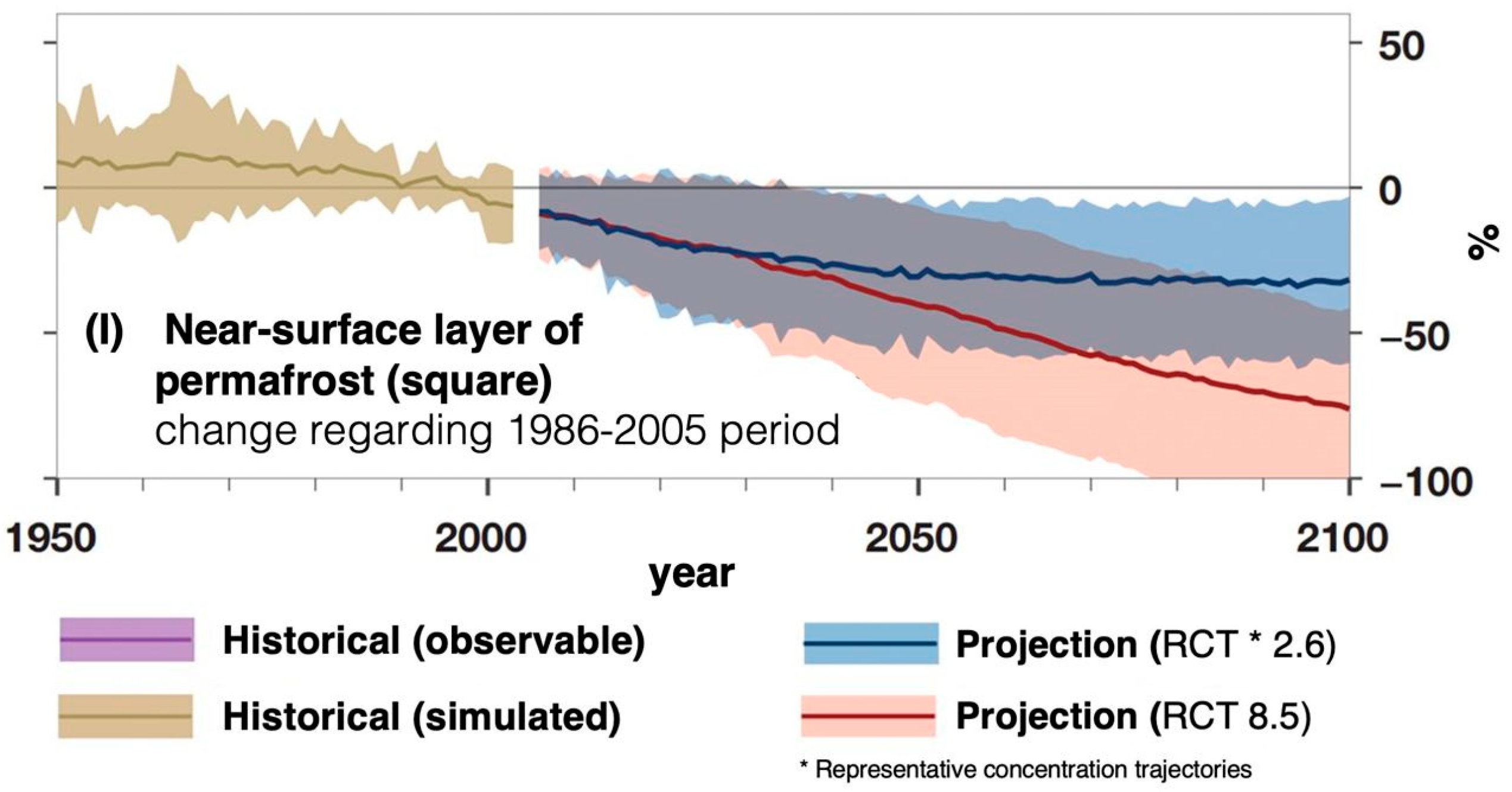

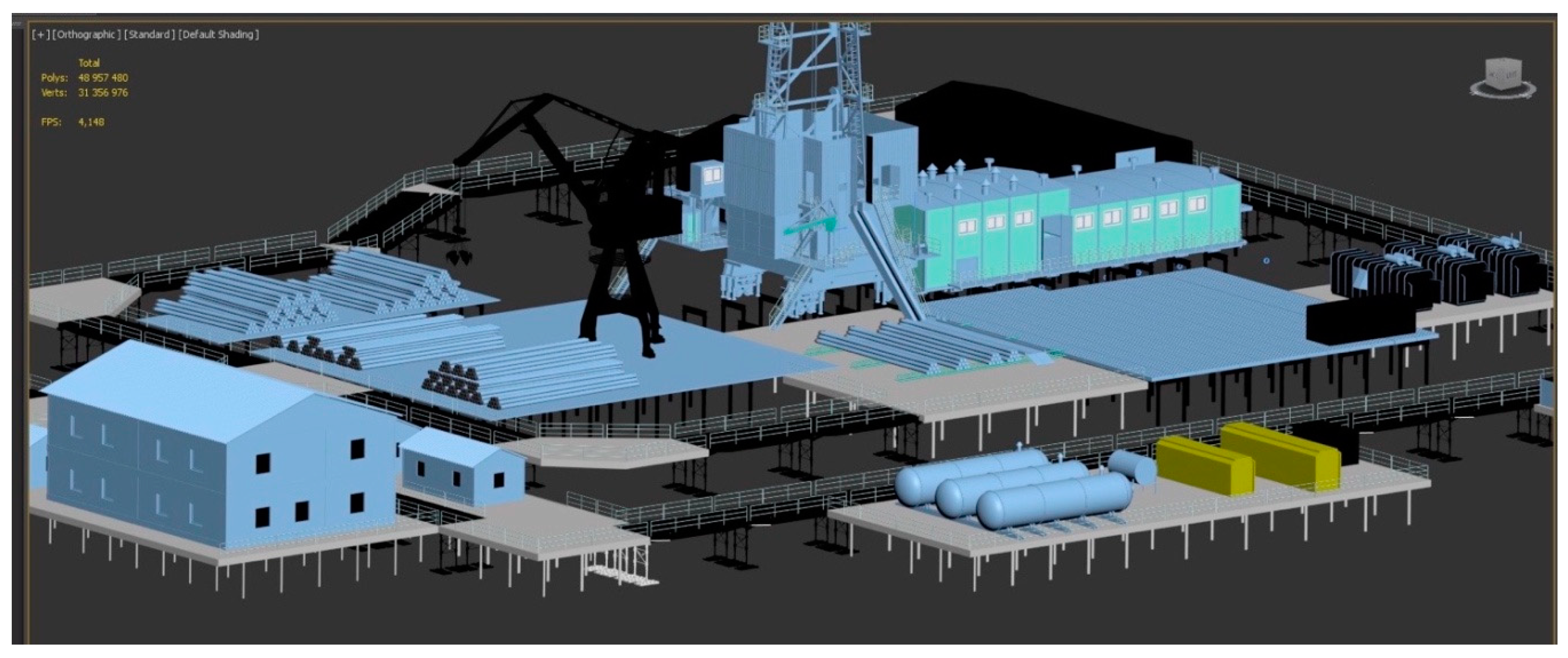
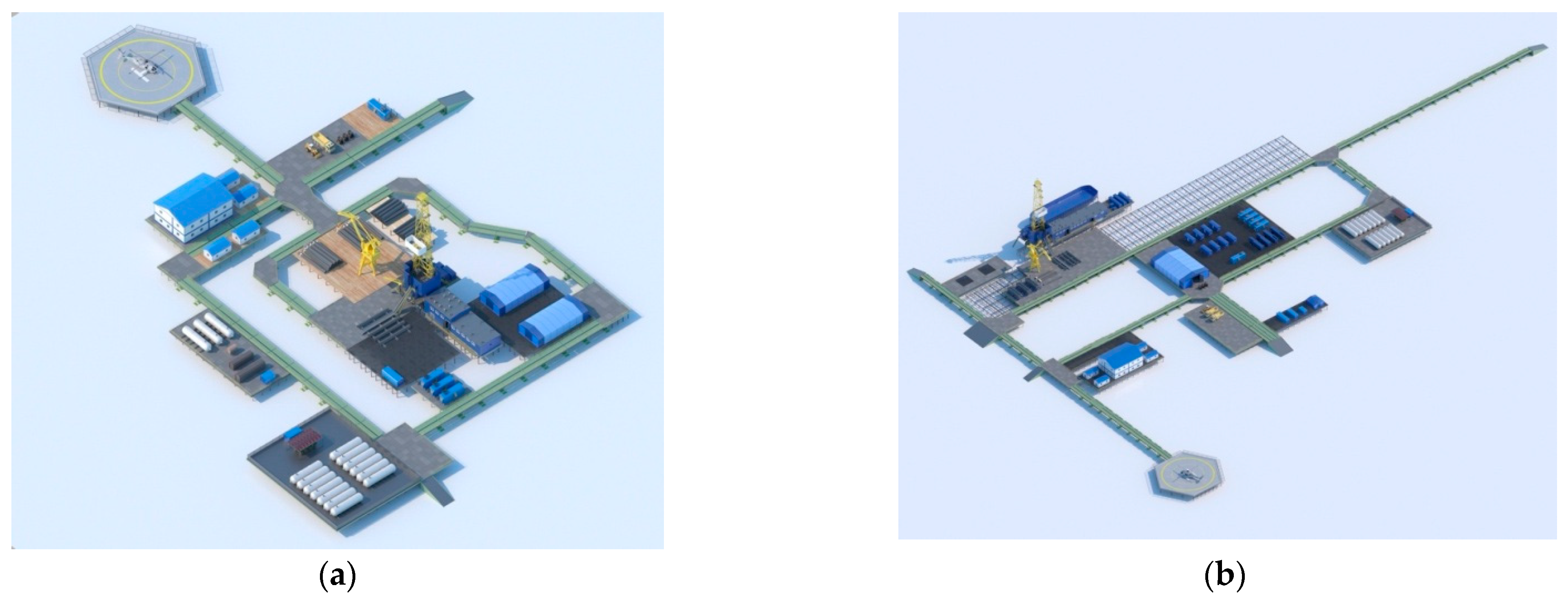
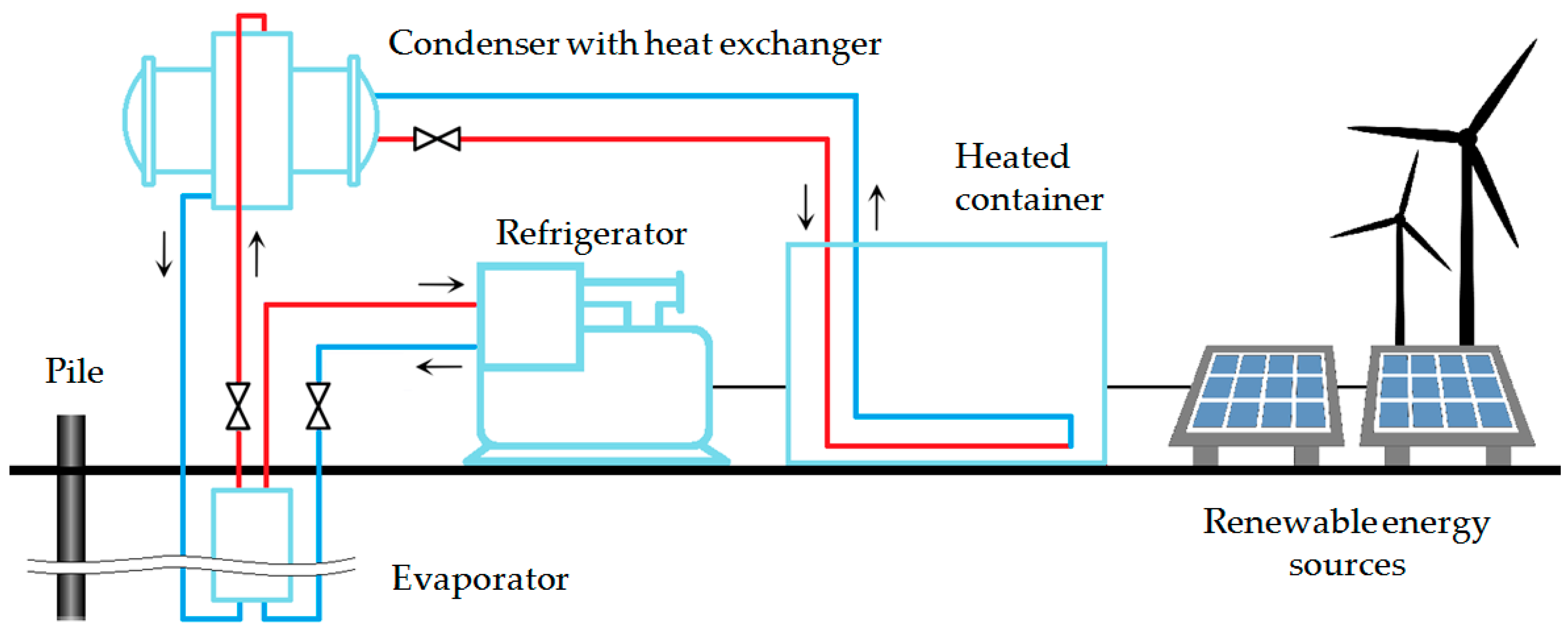

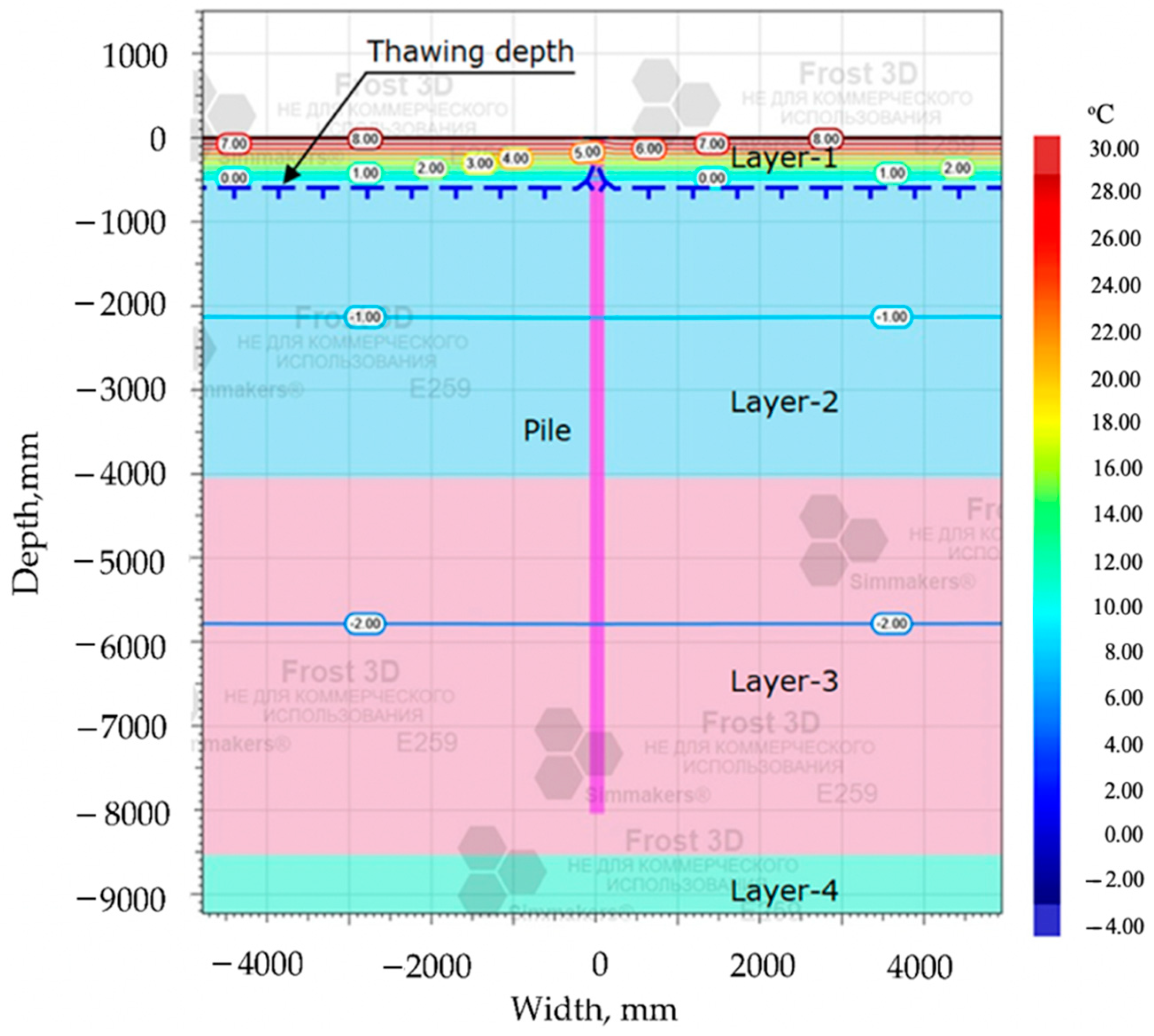
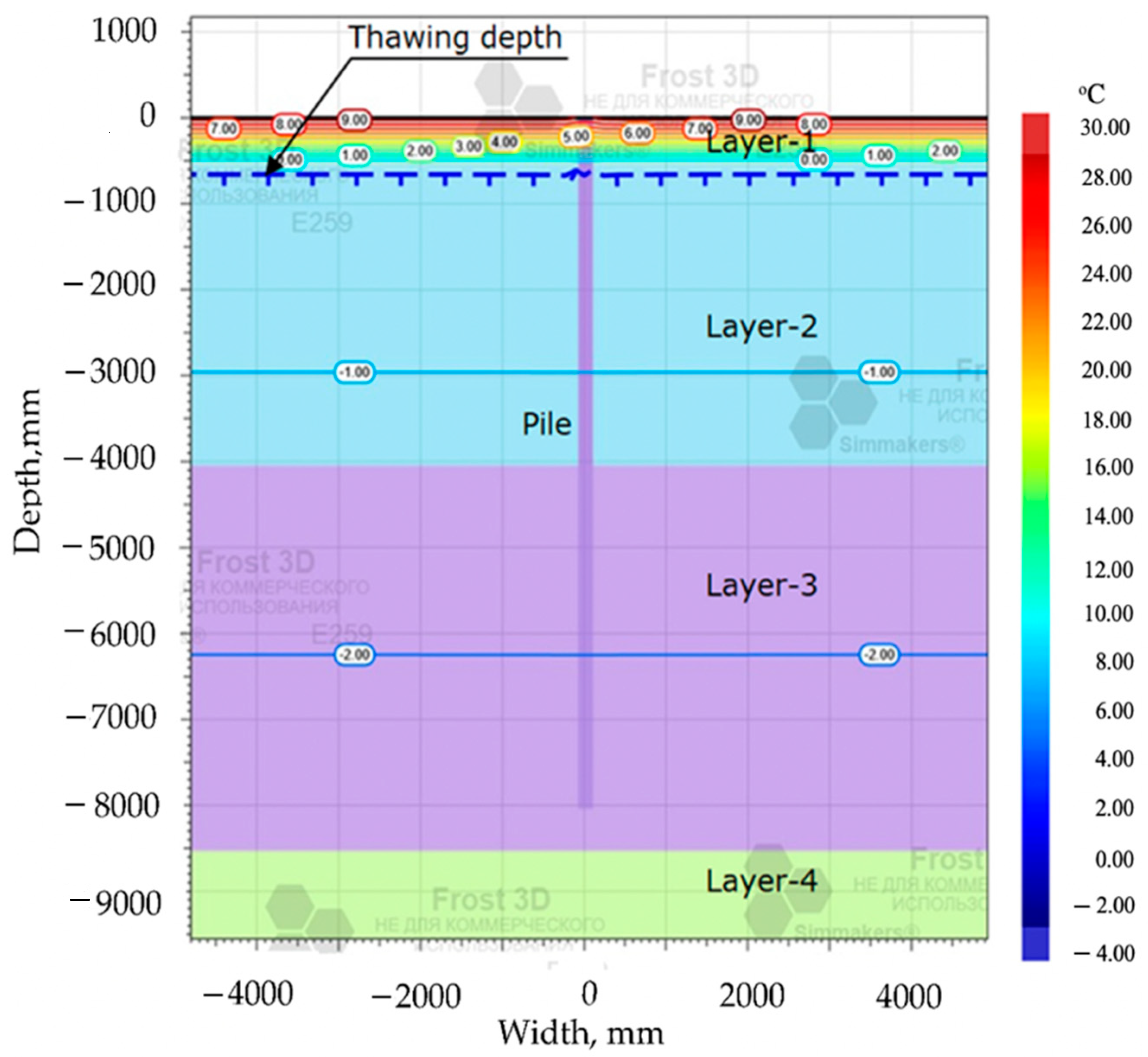
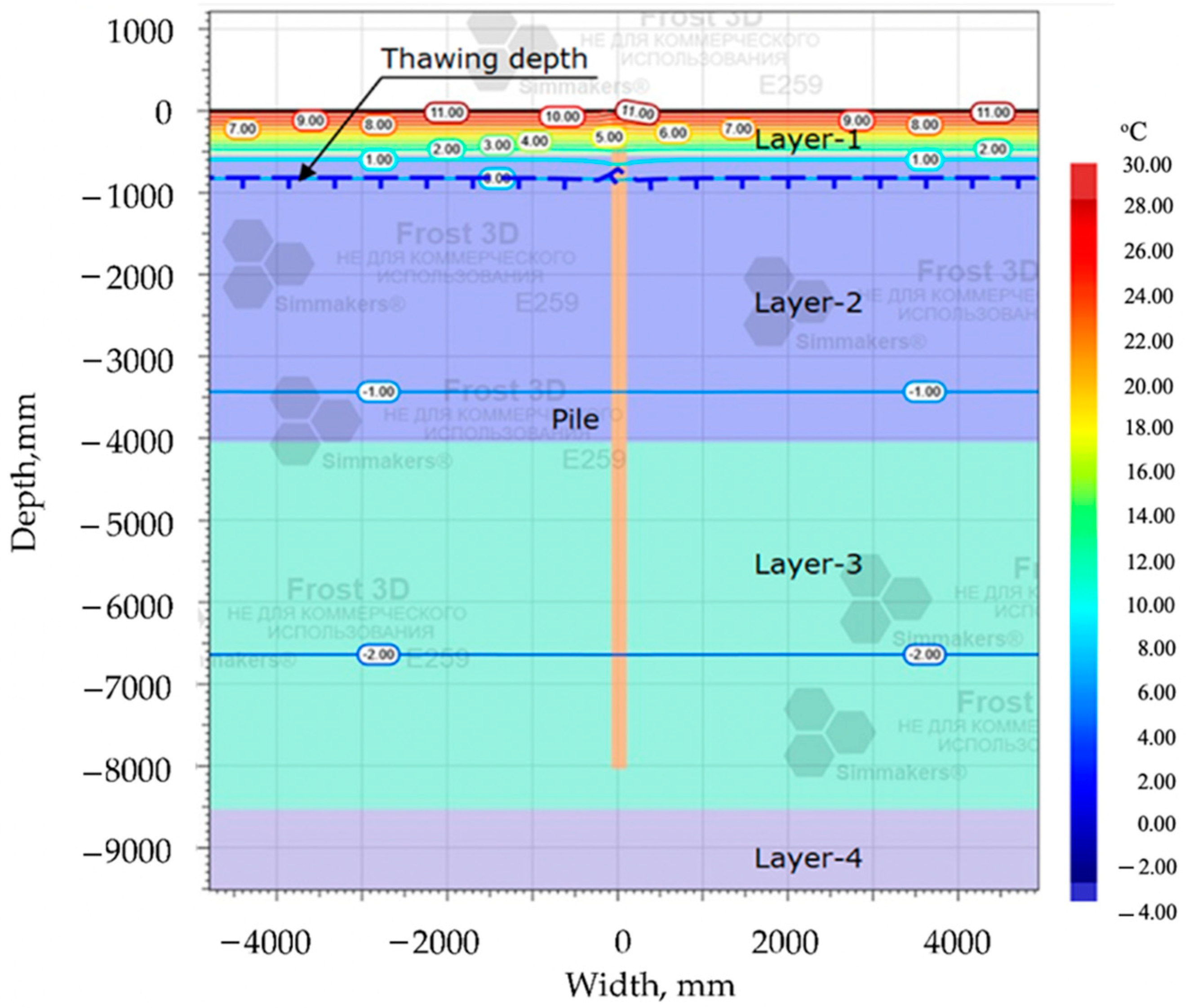
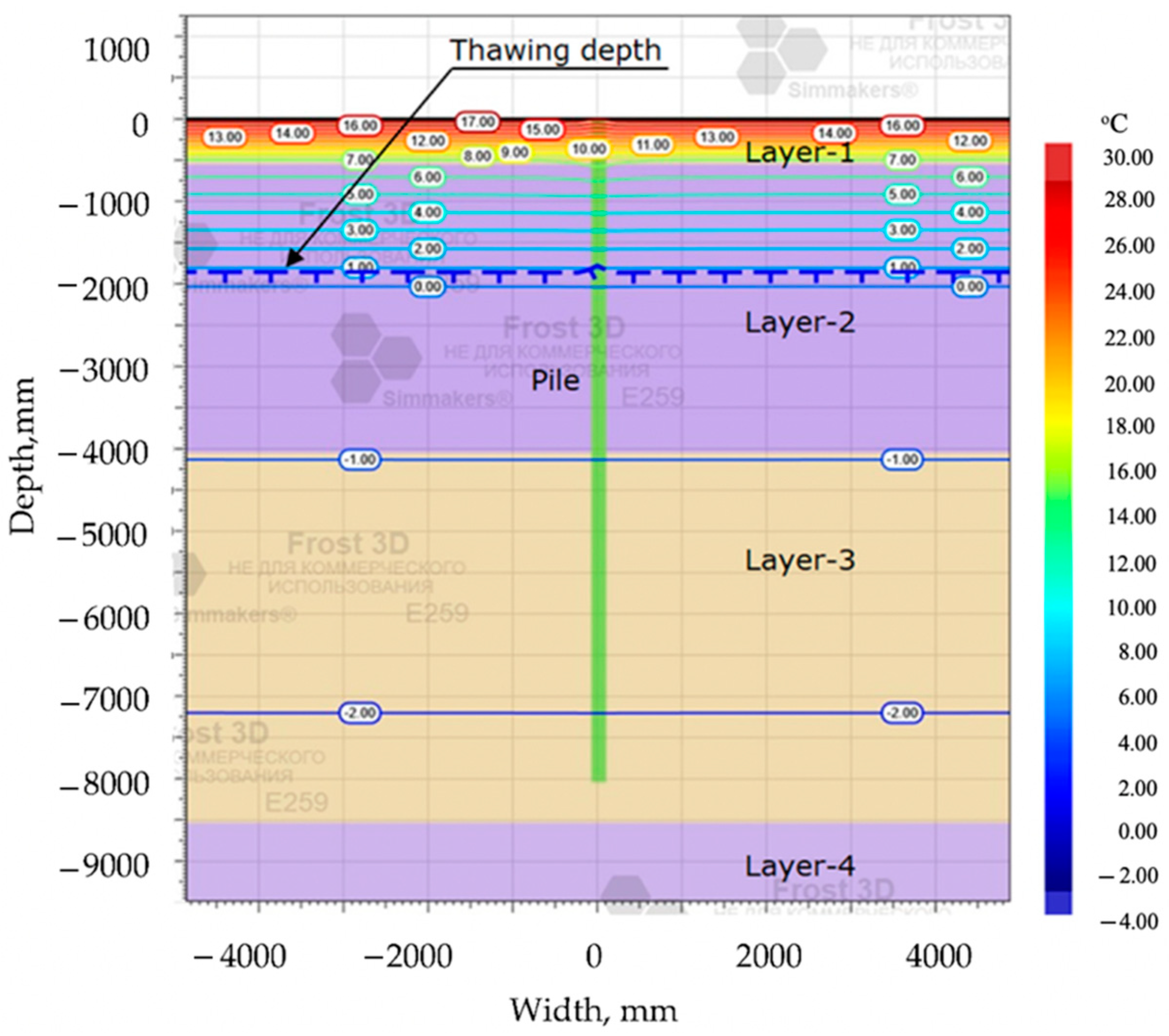
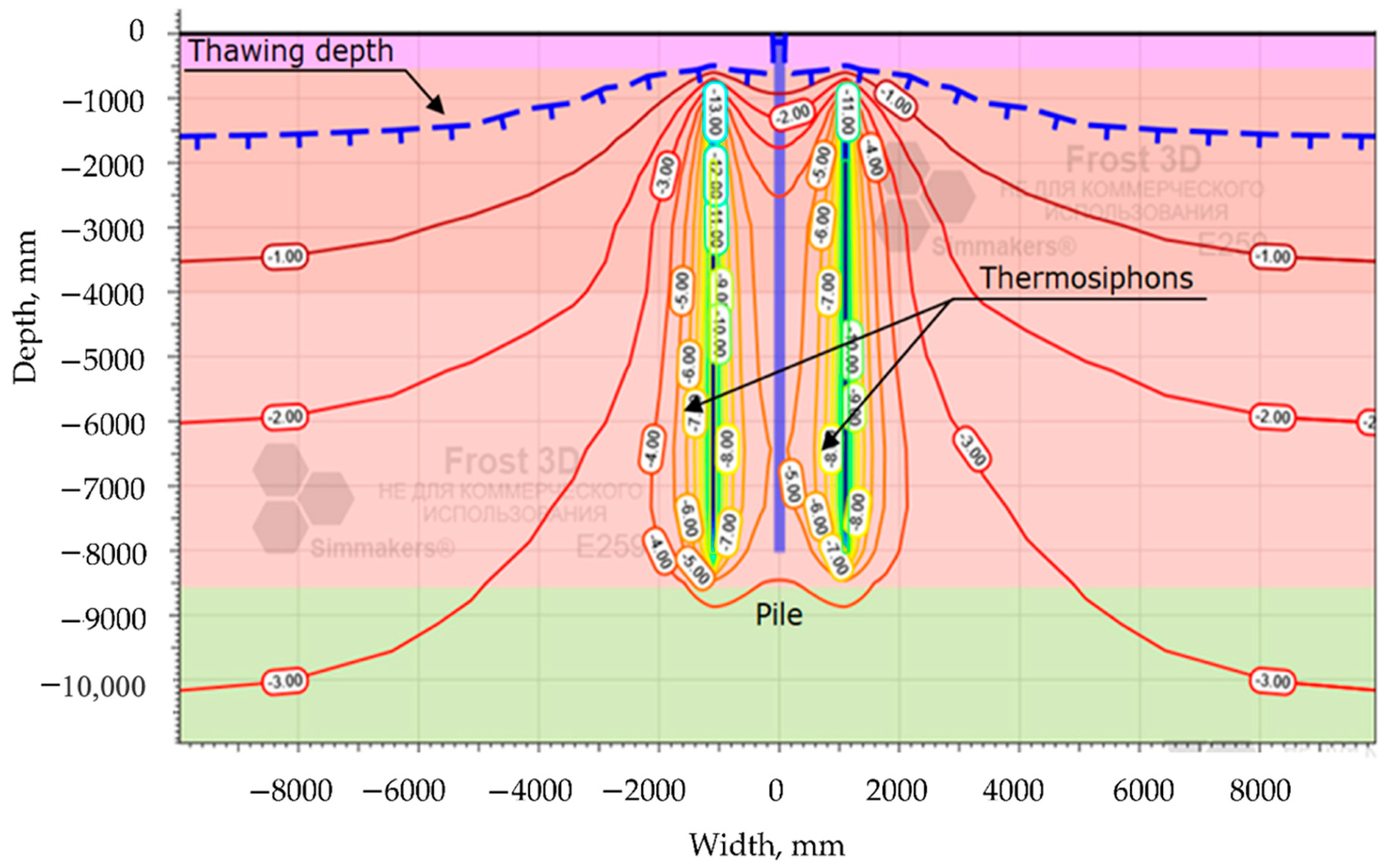
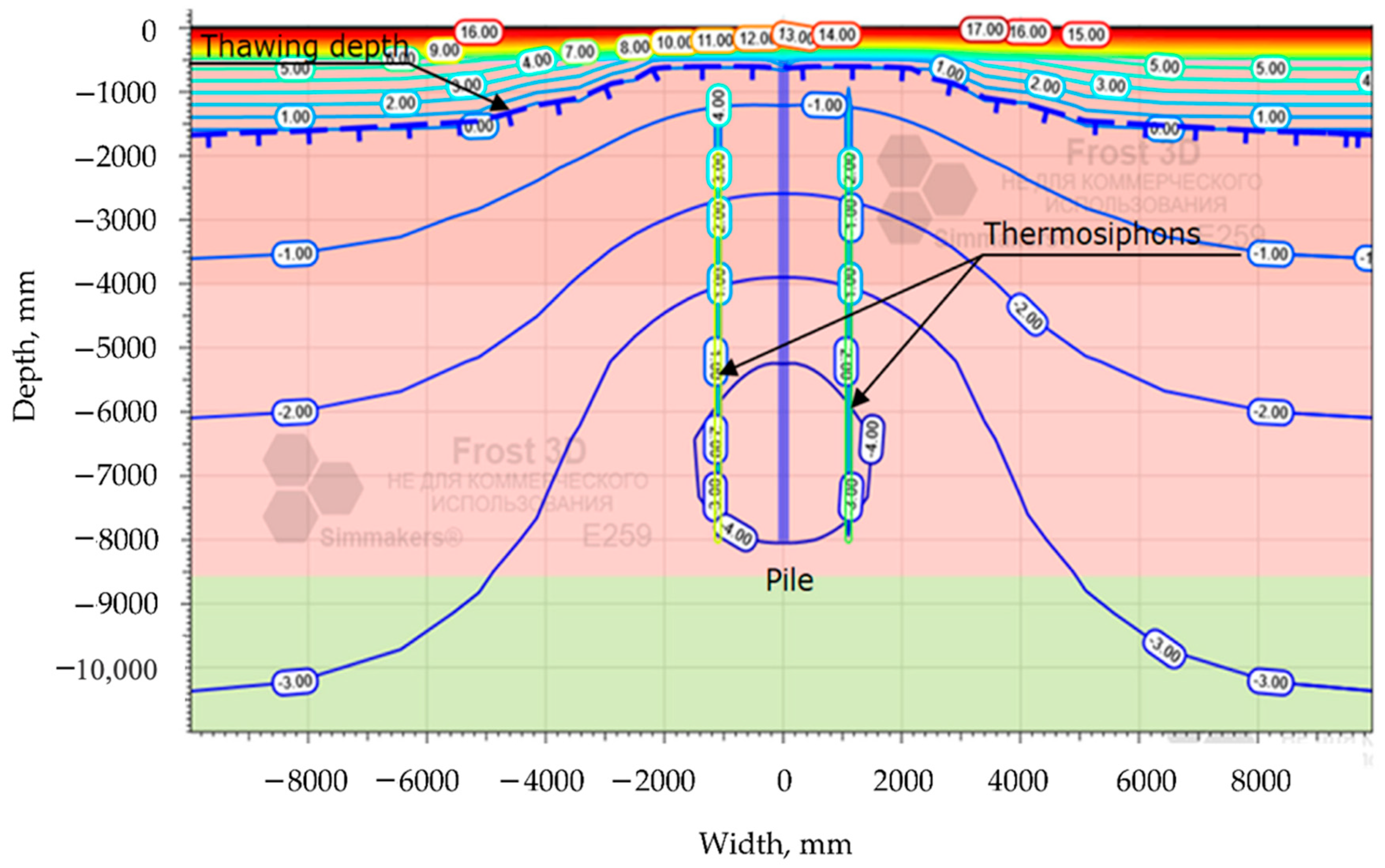

| Layer | Type of Soils | Cut Open Thickness, m | Density of Dry Soil ρd, g/cm3 | Total Humidity Wtot, d.e. |
|---|---|---|---|---|
| Layer-1 | Brown peat, malleable, highly porous | 0.5 | 0.14 | 4.82 |
| Layer-2 | Sand, fine, solid frozen | 3.5 | 1.58 | 0.23 |
| Layer-3 | Clay loam, dark gray hard frozen | 4.5 | 1.26 | 0.31 |
| Layer-4 | Sandy silt | 7.0 | 1.56 | 0.24 |
| Air Temperature, °C | ||||||||||||
| I | II | III | IV | V | VI | VII | VIII | IX | X | XI | XII | per Year |
| −23.1 | −24.6 | −20.4 | −15.3 | −6.8 | −0.7 | 6.0 | 5.8 | 2.6 | −5.8 | −14.0 | −18.7 | −9.5 |
| Wind Speed, m/s | ||||||||||||
| I | II | III | IV | V | VI | VII | VIII | IX | X | XI | XII | per Year |
| 6.4 | 6.2 | 6.3 | 6.0 | 6.3 | 5.9 | 5.4 | 5.8 | 6.4 | 6.8 | 6.8 | 7.0 | 6.3 |
| Characteristics of Piles | Warming Scenario | Increase of Temperature per Year, °C | Active Layer by 08.2050, m | Pile Bearing Capacity as of 08.2050, tons |
|---|---|---|---|---|
| L = 8 m, Ø = 0.2 m | Positive | 0.11 | 0.595 | 81.93 |
| Neutral | 0.16 | 0.673 | 75.84 | |
| Negative | 0.24 | 0.840 | 71.32 | |
| Locally negative | 0.50 | 1.868 | 63.79 |
Publisher’s Note: MDPI stays neutral with regard to jurisdictional claims in published maps and institutional affiliations. |
© 2021 by the authors. Licensee MDPI, Basel, Switzerland. This article is an open access article distributed under the terms and conditions of the Creative Commons Attribution (CC BY) license (https://creativecommons.org/licenses/by/4.0/).
Share and Cite
Buslaev, G.; Tsvetkov, P.; Lavrik, A.; Kunshin, A.; Loseva, E.; Sidorov, D. Ensuring the Sustainability of Arctic Industrial Facilities under Conditions of Global Climate Change. Resources 2021, 10, 128. https://doi.org/10.3390/resources10120128
Buslaev G, Tsvetkov P, Lavrik A, Kunshin A, Loseva E, Sidorov D. Ensuring the Sustainability of Arctic Industrial Facilities under Conditions of Global Climate Change. Resources. 2021; 10(12):128. https://doi.org/10.3390/resources10120128
Chicago/Turabian StyleBuslaev, George, Pavel Tsvetkov, Alexander Lavrik, Andrey Kunshin, Elizaveta Loseva, and Dmitry Sidorov. 2021. "Ensuring the Sustainability of Arctic Industrial Facilities under Conditions of Global Climate Change" Resources 10, no. 12: 128. https://doi.org/10.3390/resources10120128
APA StyleBuslaev, G., Tsvetkov, P., Lavrik, A., Kunshin, A., Loseva, E., & Sidorov, D. (2021). Ensuring the Sustainability of Arctic Industrial Facilities under Conditions of Global Climate Change. Resources, 10(12), 128. https://doi.org/10.3390/resources10120128








